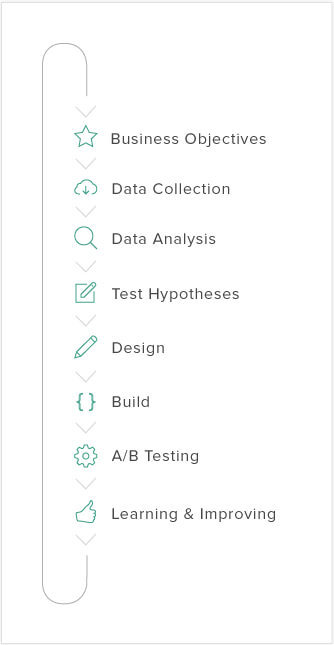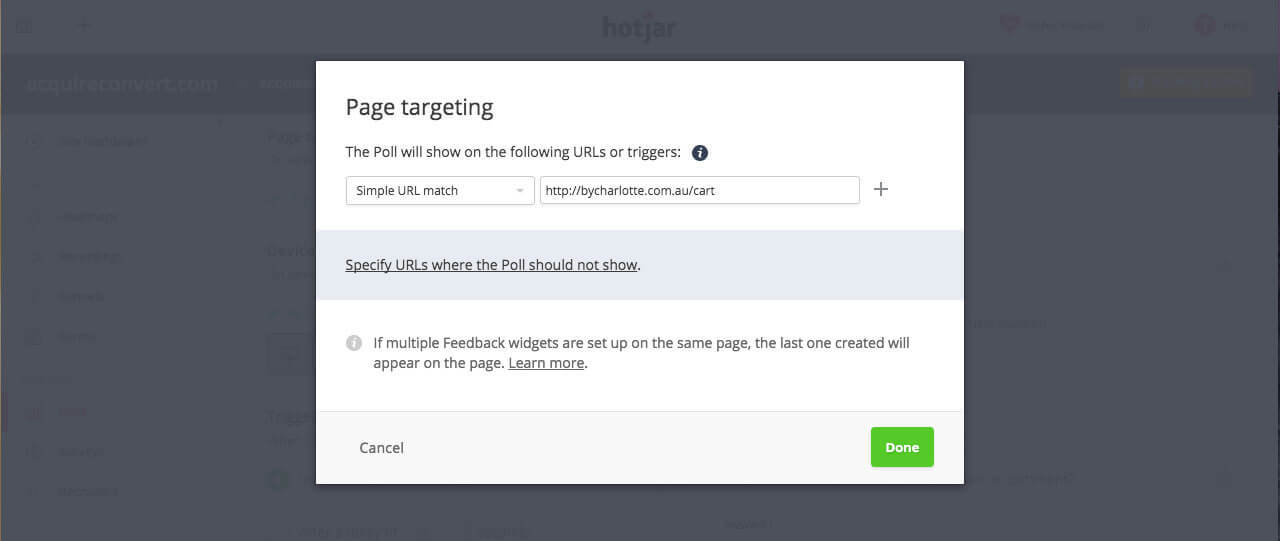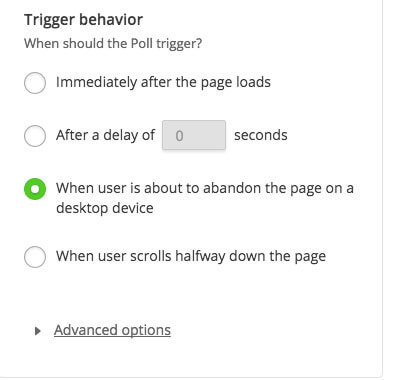How to increase conversion to ecommerce using exit polls

If you are an e-commerce business owner, and you want to increase conversion and profit, then you have come to the address. In this article, you will learn how to increase conversion with the help of a proven optimization process called “Exit intent technology” or if in Russian “exit poll”.
How to increase conversion and sales
The easiest way is to break the optimization of ecommers into two stages:
')
Stage 1 : Find out which section your visitors are leaving the site from.
Stage 2 : Find out why your visitors leave the site and change it
These two stages represent two different types of data that you can collect and analyze in order to further, based on them, increase the conversion rate of your online store.
Stage 1 is information about numbers or, as it is formally called, information about quantitative data. What people click with the mouse when they are on the site, which pages they go to and from which they leave your site. An example of a source of quantitative data is your Google Analytics account.
Stage 2 is about the behavior of site visitors, the so-called qualitative data. Why polhovateli leave the site from the basket page, why they do not understand your product descriptions, and so on. Examples of high-quality data are user testing, customer interviews, customer surveys, or a compulsory interview at the exit of the site.
How exit polling fits into the full conversion optimization process
Before you learn to collect high-quality customer data from exit polls and turn this information into money, you need to understand the whole process of optimizing your conversion factor.

Here is a general picture of this process:
Step 1 : Business Goals
The first step is the goals of the business, to put it simply, this means that you need to know how your business looks now and what your goals are for the next three months.
Step 2 : Data Collection
The second step is to collect data, as you learned above, it can be quantitative or qualitative data - in your case, you will collect data from exit polls.
Step 3 : Data Analysis
The third step is to analyze the data, understanding what the data means.
Step 4 : Hypothesis Testing
The fourth step offers an idea to match your site with your data. The “hypothesis” comes from the fact that comparison and testing is a science, but in reality it is statistics.
When checking for changes to the website you are trying to confirm your statistical hypotheses and make more money.
Step 5 and 6 : Design and Build
The fifth step is to develop and code the new website changes you are about to test.
Step 7 : A / V Testing
The seventh step is to compare and test new planned changes on the website's website with your current website to make sure the changes increase the conversion rate and your profit.
You need to make sure that your A / B testing reaches statistical significance, so do not stop this process at an early stage.
Step 8 : Iteration
The final step is to consider what you learned from your testing, whether you proved your hypothesis and, most importantly, what you learned about your customers.
Now let's dive into how to use information on exit surveys to grow e-commerce.
E-Commerce Conversion Guide with Exit Surveys
As you remember, the optimization of e-commerce in the simplest form consists of two steps. The first step is to understand exactly which page visitors leave your site, now a little more about it.
Step 1: Find where visitors leave the site
The easiest way to find out which pages of your site visitors are leaving is to view a report on Google Analytics exit pages.
To illustrate this technique, we will look at a case study for ByCharlotte (a jewelery company from Australia).

Log into your Google Analytics account and go to: Behavior> Site Content> Logout Page

Then filter the reports and delete the pages with low traffic, no traffic and too high traffic. Confirm these changes and follow the filtered settings.

Then order a report with a column of% outputs. The top pages of this report are the pages that visitors are leaving.

Step 2: Set up quit polling.
So, now you see, from what pages visitors of a site leave, now it is necessary to understand, for what reason it occurs.
In this particular example, we are using the Hotjar application. (Other applications - Foresee, Usabilla, Qualaroo). Install the software, register, enter your personal account, install the tracking code on your online store website.

The tracking code should be placed in the tag of each page that you are going to track on your site.
If you use Shopify, it is in the theme.liquid file.
Then you need to create a poll itself, in our example we are polling visitors to find out why they leave the cart page.
Go to the "Polls" menu and click on the "New poll" button.

Name your survey and write a thank you message. In our example, we are going to ask our site visitors: What stops you from buying today?

This will help us know what visitors put in the cart before completing the purchase, as well as why they leave the cart pages and leave the site.

In addition, you need to set a landing page for the survey, in our case - this is the cart page.

Finally, we come to the essence of the exit technology survey. When choosing a behavioral trigger when the survey is to be shown, select “When the user is about to leave the page”, also known as forced exit.
What is exit quiz?
This is the poll that is displayed when the user tries to leave the page or moves the cursor to the side of the browser window to close the window.

Finally, translate the survey to the “Active” stage and proceed to data collection.
Step 3: Analyze your survey data
There are three ways to analyze qualitative data. Keep in mind that when it comes to quality data, analysis takes time. The first way is to portray using a picture, i.e., taking all the answers from the exit quizzes, your client turns all words related to the problem area, for example, into a cloud of words.

In our example above, exit polls focused on delivery.
The second way is to review all the data and take into account the basic thoughts of visitors. What were the people focused on during the survey - on one obvious big flaw or on one correct goal? The goal here is to summarize each data point into one or two sentences.
In our study, people left the page due to expected delivery times, also known as delivery times. Delivery time is often considered the main reason for leaving the site basket. In our case, it was impossible to preliminarily see or calculate the approximate delivery time in the basket, as well as the cost of delivery - and these are two very great opportunities for improvement and improvement of the service.
The third way is to quantify your qualitative data by placing the data into categories. This allows you to determine how many people were focused on a major flaw on the page or on the right target. In our case, 21 of 32 visitors focused on delivery.
Step 4: A / B testing changes in your online store
At this point, you have already learned in what place and for what reason visitors leave your site. In our example, we found out that the problem page is a basket. Through a exit survey through Hotjar, we learned that people confuse the estimated delivery time and shipping cost.
Here is the initial design of the cart page:

And the updated page design:

Based on this data, we added the expected delivery date, shipping costs, as well as the shipping calculator and tested these innovations compared to the original options in order to assess the impact of the innovations.
It is important to conduct A / B testing to ensure that your new design really improves customer service and increases profits.
We added new shipping information, but at the same time we updated the design of the store theme, so we cannot attribute the increase in conversion by 20% only to the first changes.
Based on all the data we collected, delivery and estimated delivery times were recurring problems in all data sources, so we are confident that these changes played a big role in increasing the conversion by 20%, which we have achieved since the launch of the changes.
Run the growth of your online store
As you have already seen in this article, optimization of e-commerce conversion is a two-step process. Step one is to understand where visitors leave your site, step two is why. Now you know everything about collecting and analyzing qualitative data. And this analysis of qualitative data contains the key to understanding your customers, their behavior and desires.
Subscribe to our blog, then there will be a lot of interesting things.
By the way, we are engaged in complex service of online stores, maybe someone needs it? :-)
Sincerely yours, Yambox full-line operator
( Yambox - turn your online store into a computer game)

Source: https://habr.com/ru/post/304200/
All Articles